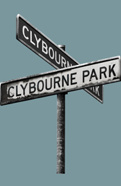Clybourne Park Star Jeremy Shamos on Riding the Wave of Audience Laughter
About the author:
Jeremy Shamos is every off-Broadway director’s secret weapon, whether the script is a comedy (Miss Witherspoon, Hunting and Gathering, Gutenberg! The Musical!), drama (100 Saints You Should Know, Animals Out of Paper) or—best of all—a comedy with dramatic heft, as in the current production of Bruce Norris’ Clybourne Park at Playwrights Horizons. It’s a hugely challenging black comedy about race, made even more so by the fact that the seven-person cast plays different roles in Act One (set in 1959) and Act Two (2009). Shamos has two of the most difficult parts to get right: smiling racist Karl Lindner (a character borrowed from A Raisin in the Sun) and a 21st-century expectant dad named Steve who gets caught in a no-win argument over gentrification. He nails both men perfectly—which led us to ask Shamos to share his thoughts on the challenge of launching new plays. As it turns out, he's plenty busy as the father of two very small children, but he kindly agreed to write about the unseen extra character in every show he does: the audience.
![]()
I don’t want to give anything away about Bruce Norris’ Clybourne Park, the play that I’m gleefully performing eight times a week at Playwrights Horizons, but there is a section near the end of the second act when the whole theater is enveloped in waves of laughter. When I say “waves,” I’m thinking of ocean waves, seemingly steady and yet wildly unpredictable. One wave feels as if it will crest and be mammoth and it dissolves, while the very next seemingly tiny ripple crests, caps and takes us on a thrilling ride. There are moments in the play that shock—and when those occur, a few people instinctually laugh, others gasp and some clam up, but mostly everyone takes a breath and looks for clues as to how to react.
What I realize as I perform this funny and provocative play eight times a week is that every night, my experience is different—excitingly so—not just because of the brilliant, spontaneous performances of the other six actors, but because of the reaction of the people who are watching it. More than any other play I’ve ever been in, Clybourne Park is a study in audience dynamics and a constant negotiation of their responses.
Now, I’ve always been fascinated with audiences and their collective “character.” In whatever way they are responding (or not responding), this group of strangers who sit in half-darkness, watching a play unfold, is an integral part of the evening. Without them, we are simply rehearsing—and it is in the navigation of their laughs, their gasps, and the particular silence that indicates information being digested that we find the magic of live performance. It is in the give and take between audience and actors that the theater becomes the event that film and television can never be.
In my most thrilling nights on stage, there is an effortless flow between the audience and the actors. The whole room, from the back row of the “house” to the back of the stage, is alive. It sounds odd, but it is as if the whole theater is one organism. Of course, in a play with a lot of laughs, the give and take is audible. And when there is no fourth wall, the connection is quite direct. A cell phone that rang during a performance of Gutenberg! The Musical! was simply a chance for us to talk more personally with a member of the audience, and the person who called!
But there are plays in which the connection is merely a feeling. I’m thinking of nights performing Tim Blake Nelson’s The Grey Zone. The play takes place inside the Auschwitz concentration camp, and as we whispered on stage, for fear of being overheard by the Nazi commandant, the audience’s silence was thick. Or Frank McGuiness’ Observe the Sons of Ulster Marching Towards the Somme, when, moments from the play’s end, we prayed before going to our deaths in the Battle of the Somme. On its best nights, the audience braced themselves for battle as well. But in both those plays, the audience’s sympathies were clear. The audience’s collective attitude fell right into place. They sympathized with our struggles and held their breath when we held our breath.
For the audience at Clybourne Park, it is not so easy. They are being asked to negotiate the tricky and awkward landscape of racial tension. The play masterfully gives them opportunities to hear things they’ve never heard and enter situations they’ve never been in, and it is amazing to listen and feel that experience. The gasps, the shared silences, the laughter that turns to gasps that turns to silence and then back into laughter. At each turn, the audience is negotiating its collective response, its collective opinion—and that, I think, is why the laughs come in these unpredictable but utterly natural currents. Sometimes the “droplets” of individual audience members align to create an enormous wave and (like thrill-seeking sailors pointing into the weather) we lucky seven actors get to ride the waves every night.

